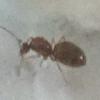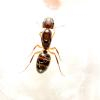- Formiculture.com
- Forums
- Gallery
- Members
- Member Map
- Chat

Temnothorax Care?
Started By
Aquaexploder
, Jul 21 2017 5:21 PM
5 replies to this topic
#1
 Offline
-
Posted July 21 2017 - 5:21 PM
Offline
-
Posted July 21 2017 - 5:21 PM
Could someone give me a little run down on this genus and tell me how to care for them please?
#2
 Offline
-
Posted July 23 2017 - 9:36 AM
Offline
-
Posted July 23 2017 - 9:36 AM
Temnothorax seem to be among the most commonly researched ants. Unless you've got one of the slave making species, they seem to be pretty easy to keep. They nest in small cavities -- like acorns and oak galls. In some of the papers I've seen, they keep them between microscope slides held apart by some paper or cardboard.
It seems like they eat a fairly typical diet for ants (so insect protein and/or Bhatkar diet plus sugar water), and need a small, pretty moist cavity. If you want, you can give them some sand to customize the nest.
It seems like they eat a fairly typical diet for ants (so insect protein and/or Bhatkar diet plus sugar water), and need a small, pretty moist cavity. If you want, you can give them some sand to customize the nest.
- Aquaexploder likes this
#3
 Offline
-
Posted July 23 2017 - 6:20 PM
Offline
-
Posted July 23 2017 - 6:20 PM
Temnothorax seem to be among the most commonly researched ants. Unless you've got one of the slave making species, they seem to be pretty easy to keep. They nest in small cavities -- like acorns and oak galls. In some of the papers I've seen, they keep them between microscope slides held apart by some paper or cardboard.
It seems like they eat a fairly typical diet for ants (so insect protein and/or Bhatkar diet plus sugar water), and need a small, pretty moist cavity. If you want, you can give them some sand to customize the nest.
Are they claustral?
#4
 Offline
-
Posted July 23 2017 - 6:41 PM
Offline
-
Posted July 23 2017 - 6:41 PM
Temnothorax seem to be among the most commonly researched ants. Unless you've got one of the slave making species, they seem to be pretty easy to keep. They nest in small cavities -- like acorns and oak galls. In some of the papers I've seen, they keep them between microscope slides held apart by some paper or cardboard.
It seems like they eat a fairly typical diet for ants (so insect protein and/or Bhatkar diet plus sugar water), and need a small, pretty moist cavity. If you want, you can give them some sand to customize the nest.
Are they claustral?
If you are asking whether they are semi-claustral or fully claustral they are fully claustral.
Edited by Bracchymyrmex, July 23 2017 - 6:41 PM.
- Aquaexploder likes this
#5
 Offline
-
Posted July 23 2017 - 9:56 PM
Offline
-
Posted July 23 2017 - 9:56 PM
While thinking about Temnothorax housing a while back, I came across this brilliant idea from ANTfinity that makes use of an eye shadow container--link below.
http://www.antfinity...or-temnothorax/
I can't imagine anything easier or cheaper for such an ideal setup. I also once saw a setup that used a hollowed out half of a nut shell glued to an acrylic lid, which seemed a bit more natural, but that was years ago. I can't remember where I saw that one.
- noebl1 and Aquaexploder like this
#6
 Offline
-
Posted July 24 2017 - 5:38 AM
Offline
-
Posted July 24 2017 - 5:38 AM
I found them pretty easy to feed. Biggest issues I had were mostly rookies mistakes due to their small size. They are really really tiny and lightly color so easy to miss and squish during maint. They also drown in food if not careful (so using cotton balls is a must when starting out with liquid foods initially.) They were also very very resistant to moving test tubes for me. This part surprised me as with some of the articles I've read online, they are supposed to be pretty ready to move locations if disturbed; will try using natural light this year to force move them. They ate pretty much anything I gave them last year, including cooked chicken kitchen scraps.
This season I've tried founding them with 2-4 queens per tube to see if I can give them a bit of boost brood wise to increase odds. They also went from alates in tubes to laying eggs to hatching pretty quickly too. Wings/no wings does not seem to be an indicator for fertility.
Edited by noebl1, July 24 2017 - 5:39 AM.
- Aquaexploder likes this
1 user(s) are reading this topic
0 members, 1 guests, 0 anonymous users

















